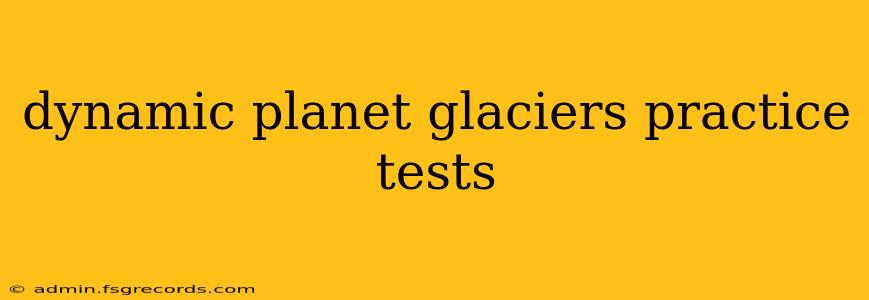Glaciers, majestic rivers of ice, are powerful forces shaping our planet. Understanding their formation, movement, and impact is crucial for comprehending Earth's dynamic systems. This guide provides practice tests and a comprehensive study resource for anyone learning about glaciers as part of a Dynamic Planet curriculum or simply wanting to expand their knowledge of these fascinating natural phenomena.
Understanding Glaciers: Key Concepts
Before diving into the practice tests, let's review some essential concepts:
Types of Glaciers
- Alpine Glaciers (Mountain Glaciers): Found in mountainous regions, these glaciers flow down valleys, carving U-shaped valleys and contributing to landforms like cirques and moraines.
- Continental Glaciers (Ice Sheets): Vast sheets of ice covering large land areas, like those found in Greenland and Antarctica. These are responsible for widespread glacial erosion and deposition.
Glacial Formation and Movement
- Snow Accumulation: Glaciers form when snow accumulates over time, compressing into denser ice.
- Glacial Flow: The immense weight of the ice causes it to flow slowly under its own gravity, driven by both internal deformation and basal sliding.
- Glacial Budget: The balance between snow accumulation (input) and ice loss through melting and calving (output) determines whether a glacier advances or retreats.
Glacial Erosion and Deposition
- Erosion: Glaciers are incredibly powerful erosional forces, carving valleys, transporting sediment, and creating unique landforms. Processes include abrasion (scraping) and plucking (lifting and carrying rocks).
- Deposition: As glaciers melt or slow down, they deposit the sediment they've carried, creating moraines, eskers, drumlins, and other glacial landforms.
Glacial Impacts on the Environment
- Sea Level Rise: Melting glaciers contribute significantly to rising sea levels, posing a serious threat to coastal communities.
- Climate Change: Glaciers are sensitive indicators of climate change, with their size and extent reflecting changes in temperature and precipitation.
- Water Resources: Glaciers are important freshwater reservoirs, providing water for millions of people.
Practice Test 1: Multiple Choice
-
Which type of glacier covers vast land areas? a) Alpine Glacier b) Valley Glacier c) Continental Glacier d) Piedmont Glacier
-
What is the process by which glaciers pick up and transport rocks? a) Abrasion b) Plucking c) Calving d) Deposition
-
A glacier's balance between snow accumulation and ice loss is called: a) Glacial Budget b) Glacial Flow c) Glacial Erosion d) Glacial Deposition
-
U-shaped valleys are characteristic features formed by: a) River erosion b) Wind erosion c) Alpine glaciers d) Continental glaciers
-
Which of the following is NOT a landform created by glacial deposition? a) Moraine b) Cirque c) Drumlin d) Eskers
Practice Test 2: True or False
- All glaciers are located in mountainous regions. (True/False)
- Glacial ice flows primarily due to gravity. (True/False)
- Melting glaciers have no impact on sea levels. (True/False)
- Abrasion is a process of glacial erosion. (True/False)
- Glaciers only contribute to erosion, not deposition. (True/False)
Answer Key (For both Practice Tests)
Practice Test 1: 1. c, 2. b, 3. a, 4. c, 5. b Practice Test 2: 1. False, 2. True, 3. False, 4. True, 5. False
Further Study and Resources
To further enhance your understanding of glaciers and their role within the dynamic planet system, consider exploring resources such as introductory geology textbooks, reputable online encyclopedias, and scientific publications. Looking at high-resolution satellite imagery of glaciers can provide a visual understanding of their scale and impact.
This study guide and practice tests provide a foundational understanding of glaciers. Remember that continuous learning and exploration are essential for mastering this complex and fascinating topic.

